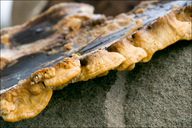|
|
click photo for larger file

Antrodia malicola
|
Photographer: Dr. Amadej Trnkoczy
ID: 0000 0000 0313 2837 (2013-03-17)Copyright © 2013 Dr. Amadej Trnkoczy
|
|
INFORMATION PROVIDED WITH THE PHOTO
|
date of photo Jan 24, 2013
latitude 46.32658 longitude 13.52205
View on Google Maps.
location
Bovec basin, south of Bovec golf play ground, East Julian Alps (Posočje, Slovenia)notes UPDATED INFORMATION: Antrodia malicola, syn. Coriolellus malicola (Berk. & M.A. Curtis) Murrill (1920), Daedalea malicola (Berk. & M.A. Curtis) Aoshima (1967), Trametes jamaicensis Murrill (1910), Trametes malicola Berk. & M.A. Curtis (1856) Slo.: rjavkasta trhlica Date: Jan. 30. 2014 A piece of herbarium specimen has been sent to Mr. Günter Sturm, Germany for evaluation. He has a very long 'mileage' with Polyporaceae. His habit and microscopic examination yields Antrodia malicola. This is a rather rare polypore (found in three MTB sub-squares in Slovenia) with clamped septs of the hypha and dimitic hypha system. He also found and examined a few spores. All characteristics meet the expectations for this species. He also mentions that, although Antrodia doesn’t belong to the Hymenochaetaceae, A. malicola is an exception and reacts with KOH by blackening as it is demonstrated also on one of the pictures attached to the observation Antrodia malicola - I. In the Rhine-Main-Area of Germany, where he lives, they have about 20 finds of A. malicola up to now and he knows the taxon well. The main substrate is Fagus, but it was found also on Carpinus. The mushroom has a fine-aromatic smell, which I somehow overlooked. Günter thank you for your interest and time. _______________________________ Former text: Slo.: Žafranasti (?) zlatoluknjičar - Coriolopsis trogii (Berk.) Dom., syn: Trametes trogii Berk or Hapalopilus croceus ? (Pers.) Donk, syn.: Aurantiporus croceus, Inonotus croceus, Phaeolus croceus, Tyromyces croceus - Habitat: Former pasture, on top of a pile of firewood; flat terrain, calcareous ground, full sun, exposed to direct rain, average precipitations ~ 3.000 mm/year, average temperature 8-10 deg C, elevation 400 m (1.300 feet), alpine phytogeographical region. - Substratum: a cut down, dead, rotten but partly still in bark trunk of Ostrya carpinifolia (about 15 cm diameter) used as a weight and laying on a pile of firewood. - Comments: Two weeks after the first observation I went back to the place, took some additional pictures and samples and did some microscopy. I found several new fruit bodies (pictures added) as well as the old ones, which haven�t changed much in size and appearance. The new ones were on a different larger ~ 20 cm diameter log a few meters away of the first find on the same substratum. This time I found also two fully resupinated basidiocarps. - To my big surprise, I was unable to find a single spore this time! I scoped hypha of trama and tube layer and basidia. All following comparisons relate to information given in Ref.:(4). Trama hypha seems to be monomitic, a characteristics of H. croceus. I was unable to find any trace of trimitic hypha, which is characteristic to Coriolopsis trogii. Hypha is quite uniform, dense, thin-walled, rarely branched, which also corresponds to H. croceus. It has somewhat larger diameter (measured average value d=3.8μ, SD=0.5μ, n=30 and data of H.croceus = 3-6μ) than C. trogii (generative hypha d=2-3,5(4)). C. trogii has richly branched, thick-walled skeletal and binding hypha, which I was unable to find. Basidia dimensions (measured average l=25.8μ, SD=3.5μ and d=6.4μ SD=1.0μ, n=15) and lack of cystidia fit well to both species. Their shape is generally clavate (which fits to both species), but many are (double) flash shaped, which is not mentioned in the literature available to me. KOH 5% test on trama was again violent, dark red-black. Ref.:(4) states �carmine red� for H. croceus and �unchangeable or only slightly darkening� for C. trogii. H.croceus causes white root, which can be seen from one of the added pictures. I haven�t found this information for C. trogii. - On the other hand, both species should have hypha with clamps and also basidia should have basal clams. I haven't found clamps (poor microscopy?). - Re: substratum. Ref.:(4) and Ref.:(3) state Quercus sp./Castanea sp. for H. croceus and Populus sp./Salix sp. for C. trogii. In my observation it was almost certainly Ostrya carpinifolia, which seems to be closer to Quercus sp. from the stand point of wood properties (very heavy and hard, historically used to fashion plane soles). - I don�t know how to interpret this data. What puzzle me are spores � wrong dimensions in the first visit and apparent absence of hypha clamps. Could this observation be something third? - Ref.: (1) Personal communication, provisionally id'ed as Hapalopilus by Mr. Anton Poler. (2) Personal communication, provisionally id�ed as Trametes trogii by Mr. Gregor Podgornik, NAC Tolmin. (3) G.J.Krieglsteiner (Hrsg.), Die Grosspilze Bade-W�rttembergs, Band 1, Ulmer (2000), p 532 and 505. (4) A.Bernicchia, Polyporaceae s.l., Fungi Europaei, Vol. 10., Edizioni Candusso (2005), p 256 and 190.camera Nikon D700 / Nikkor Micro 105mm/f2.8
contributor's ID # Bot_687/2013_IMG5952 photo category: Fungi - fungi
|
MORE INFORMATION ABOUT THIS FUNGUS
|
| View all photos in CalPhotos of Antrodia malicola Check Google Images for Antrodia malicola |
|
The photographer's identification Antrodia malicola has not been reviewed. Click here to review or comment on the identification. |
|
Using this photo The thumbnail photo (128x192 pixels) on this page may be freely used for personal or academic purposes without prior permission under the Fair Use provisions of US copyright law as long as the photo is clearly credited with © 2013 Dr. Amadej Trnkoczy.
For other uses, or if you have questions, contact Dr. Amadej Trnkoczy amadej.trnkoczy[AT]siol.net. (Replace the [AT] with the @ symbol before sending an email.) |
|
|
